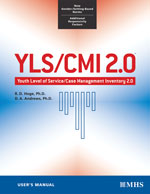
YLS/CMI™
Youth Level of Service/Case Management Inventory™
A risk/needs assessment derived from the LSI-R, designed specifically for adolescents
Filters
Upgrade to YLS/CMI 2.0 now!
It’s time to make the switch. YLS/CMI 2.0 offers a larger normative sample, expanded age eligibility, enhanced non-criminogenic needs, and updated cut-offs. Don’t miss out on critical advancements—upgrade today to ensure you’re using the best tools available.
The Youth Level of Service/Case Management Inventory™ (YLS/CMI™) is a risk/needs assessment and a case management tool combined into one convenient system. It was derived from the Level of Service Inventory-Revised™ (LSI-R™), but was designed specifically for adolescents. It helps probation officers, youth workers, psychologists, and social workers identify the individual’s needs, strengths, barriers, and incentives. This information helps you to select the most appropriate goals for a youth and to develop an effective case management plan.
Age
- 12 to 17
Administration Type
- Professional
- Interview
Administration Time
- 15 to 30 Minutes; interview varies
Number of Items
- Section 1: 42
- Section 2-7: varies
Qualification Level
- B
Format(s)
- Handscored
- Software (Administration & Scoring)
Profile Reports summarize the results of an individual administration, providing scores for all scales.
Comparative Reports show progress over time, comparing up to four assessments for the same justice-involved individual. They are free with the purchase of Profile Reports.
YLS/CMI QuikScore™ Form
The YLS/CMI QuikScore™ Form is completed by the professional and consists of four sections. Part I provides a survey of all the risk and need factors that might be exhibited by the youth. Part II provides an overall risk/need score and summary of the individual risk/need levels recorded in Part I. Part III provides a section where the assessor can record information about a range of variables, since these might be relevant to disposition or intervention decisions about the client. Finally, Part IV provides the assessor with a professional override to consider all the information about the client and provide their estimate of the risk level involved.
Case Management Review Form
The YLS/CMI Case Management Review Form is designed to help review case progress.
The YLS/CMI is available in handscored and software formats. With the handscored format, you use an Interview Guide to complete the interview component and then record your ratings and other information on a QuikScore Form and Case Management Form. With the software format, you can instantly generate Profile Reports upon completion of the assessment.
The YLS/CMI has strong validity and reliability. The manual covers the historical foundation upon which YLS/CMI is based and offers three case studies that illustrate the interpretation and use of YLS/CMI in different situations.
Predictive validity data for the total risk need score and eight subscores, inter-rater agreement reliability, construct validity, and criterion-related validity are detailed in the YLS/CMI User’s Manual.
The normative sample for the risk/needs component of the YLS/CMI consisted of 263 (173 male and 90 female) justice-involved individuals who had received a probation or custody disposition. They ranged in age from 12 to 17 years.
To administer the YLS/CMI 2.0 training is required for those who do not have the requisite b-level educational qualifications. Training is also recommended for those who need in-depth knowledge of the YLS/CMI 2.0 and its use and interpretation. By attending our YLS/CMI 2.0 User Training, you will learn necessary skills for interviewing a justice-involved youth, accurately scoring an YLS/CMI 2.0 assessment, as well as enhancing the quality of case management, treatment planning, and service delivery. Individuals interested in becoming a YLS/CMI 2.0 Trainer or Master Trainer should complete a YLS/CMI 2.0 Trainer training session.
Learn about our On Demand Trainings.

